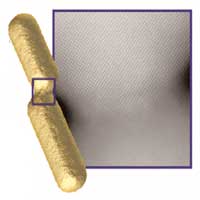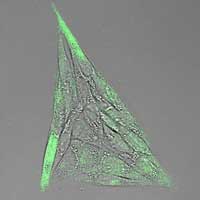 Sub-nanometer particles are very popular because of their diverse applications, but technical difficulties in their synthesis has hindered research in this field. Scientists used an 'atom-hybridization method' to overcome this barrier.
Sub-nanometer particles are very popular because of their diverse applications, but technical difficulties in their synthesis has hindered research in this field. Scientists used an 'atom-hybridization method' to overcome this barrier.
Monday, September 14, 2020
Sub-nanoparticle catalysts made from coinage elements as effective catalysts
 Sub-nanometer particles are very popular because of their diverse applications, but technical difficulties in their synthesis has hindered research in this field. Scientists used an 'atom-hybridization method' to overcome this barrier.
Sub-nanometer particles are very popular because of their diverse applications, but technical difficulties in their synthesis has hindered research in this field. Scientists used an 'atom-hybridization method' to overcome this barrier.
E-Beam atomic-scale 3D 'sculpting' could enable new quantum nanodevices
 By varying the energy and dose of tightly-focused electron beams, researchers have demonstrated the ability to both etch away and deposit high-resolution nanoscale patterns on two-dimensional layers of graphene oxide.
By varying the energy and dose of tightly-focused electron beams, researchers have demonstrated the ability to both etch away and deposit high-resolution nanoscale patterns on two-dimensional layers of graphene oxide.
Physicists 'trick' photons into behaving like electrons using a 'synthetic' magnetic field
 Scientists have discovered an elegant way of manipulating light using a 'synthetic' Lorentz force - which in nature is responsible for many fascinating phenomena including the Aurora Borealis.
Scientists have discovered an elegant way of manipulating light using a 'synthetic' Lorentz force - which in nature is responsible for many fascinating phenomena including the Aurora Borealis.
Infinite chains of hydrogen atoms have surprising properties, including a metallic phase
 An infinite chain of hydrogen atoms is just about the simplest bulk material imaginable - a never-ending single-file line of protons surrounded by electrons. Yet a new computational study combining four cutting-edge methods finds that the modest material boasts fantastic and surprising quantum properties.
An infinite chain of hydrogen atoms is just about the simplest bulk material imaginable - a never-ending single-file line of protons surrounded by electrons. Yet a new computational study combining four cutting-edge methods finds that the modest material boasts fantastic and surprising quantum properties.
New method to design diamond lattices and other crystals from microscopic building blocks
 Researchers describe a technique for using LEGO-like elements at the scale of a few billionths of a meter. Further, they are able to cajole these design elements to self-assemble, with each LEGO piece identifying its proper mate and linking up in a precise sequence to complete the desired nanostructure.
Researchers describe a technique for using LEGO-like elements at the scale of a few billionths of a meter. Further, they are able to cajole these design elements to self-assemble, with each LEGO piece identifying its proper mate and linking up in a precise sequence to complete the desired nanostructure.
Rubbery properties help RNA nanoparticles target tumors efficiently and quickly leave body
 A new study shows that RNA nanoparticles have elastic and rubbery properties that help explain why these particles target tumors so efficiently and why they possess lower toxicity in animal studies.
A new study shows that RNA nanoparticles have elastic and rubbery properties that help explain why these particles target tumors so efficiently and why they possess lower toxicity in animal studies.
Nanoballs packed under spherical confinement adopt a special structure
 Researchers solve the mystery of observed quasi-crystalline structures with the help of state-of-the-art electron microscopy.
Researchers solve the mystery of observed quasi-crystalline structures with the help of state-of-the-art electron microscopy.
How a few atoms can influence materials' properties
 A closer look at gold nanoparticles, which were welded together by laser excitation, revealed interesting insights on the atomic structure and how it influences the physical properties of the system.
A closer look at gold nanoparticles, which were welded together by laser excitation, revealed interesting insights on the atomic structure and how it influences the physical properties of the system.
Researchers create morphing crystals powered by water evaporation
 New study details the molecular-level design of materials that enable clean and sustainable water evaporation energy to be harvested and efficiently converted into motion with the potential to power future mechanical devices and machines.
New study details the molecular-level design of materials that enable clean and sustainable water evaporation energy to be harvested and efficiently converted into motion with the potential to power future mechanical devices and machines.
First fiber-optic nanotip electron gun enables easier nanoscale research
 Scientists have developed an easier way to generate electrons for nanoscale imaging and sensing, providing a useful new tool for material science, bioimaging and fundamental quantum research.
Scientists have developed an easier way to generate electrons for nanoscale imaging and sensing, providing a useful new tool for material science, bioimaging and fundamental quantum research.
Bioactive nano-capsules to hijack cell behavior
 Scientists succeeded in having several different nanocapsules work in tandem to amplify a natural signaling cascade and influence cell behavior.
Scientists succeeded in having several different nanocapsules work in tandem to amplify a natural signaling cascade and influence cell behavior.
Boron nitride nanocoatings could replace antibiotics while protecting against bacterial and fungal infections
 Material scientists have presented antibacterial nano-coatings based on boron nitride, which are highly effective against microbial pathogens (up to 99.99%). They can become a safe alternative to the usual antibiotics in implantology since they do not have typical negative side effects.
Material scientists have presented antibacterial nano-coatings based on boron nitride, which are highly effective against microbial pathogens (up to 99.99%). They can become a safe alternative to the usual antibiotics in implantology since they do not have typical negative side effects.
DNA damage caused by migrating light energy
 Ultraviolet light endangers the integrity of human genetic information and may cause skin cancer. For the first time, researchers have demonstrated that DNA damage may also occur far away from the point of incidence of the radiation.
Ultraviolet light endangers the integrity of human genetic information and may cause skin cancer. For the first time, researchers have demonstrated that DNA damage may also occur far away from the point of incidence of the radiation.
Thermally conductive nanocomposite film: A better way to dissipate heat of electronic devices
 Researchers have developed highly thermally conductive polyimide film with superior flexibility and electrical insulation.
Researchers have developed highly thermally conductive polyimide film with superior flexibility and electrical insulation.
Single atom-thin platinum makes a great chemical sensor
 Scientists have discovered the possibility to prepare one-atom thin platinum for use as a chemical sensor.
Scientists have discovered the possibility to prepare one-atom thin platinum for use as a chemical sensor.
Subscribe to:
Comments (Atom)
